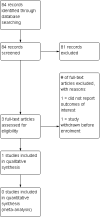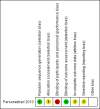Aromatase inhibitors for uterine fibroids
- PMID: 24151065
- PMCID: PMC11366412
- DOI: 10.1002/14651858.CD009505.pub2
Aromatase inhibitors for uterine fibroids
Abstract
Background: Uterine fibroids, also called uterine leiomyomas or myomas, are the most common benign tumours in women of reproductive age. Albeit generally benign, uterine fi broids can have a major impact on women's health and quality of life by contributing to abnormal uterine bleeding and causing pelvic pressure symptoms (such as increased urinary frequency, pelvic pain and constipation). Traditional treatments for symptomatic fi broids include a variety of surgical techniques. However, because of the high recurrence rate, as well as possible pain and infertility caused by the formation of postoperative adhesions, this approach may not be advisable. Safer and more effective medical therapy has long been awaited. Both in vitro studies and clinical trials have suggested that use of the aromatase inhibitors (AIs), a class of anti-oestrogens, might inhibit fi broid growth, thereby eliminating the need for surgery.
Objectives: To evaluate the effectiveness and safety of aromatase Inhibitors (AIs) in women with uterine fibroids.
Search methods: We searched the following databases (from inception to August 21, 2013): Cochrane Menstrual Disorders and Subfertility Group Specialised Register, Cochrane Central Register of Controlled Trials (CENTRAL) (The Cochrane Library), MEDLINE, EMBASE, CINAHL and PsycINFO. In addition, the reference lists of included trials were searched, and experts in the field were contacted.
Selection criteria: Randomised controlled trials (RCTs) in women of reproductive age comparing the effects of any AI versus placebo, no treatment or any medical treatment/surgery were included.
Data collection and analysis: Selection of eligible trials, assessment of trial quality and data extraction were performed independently by two review authors. If data were available, we planned to calculate odds ratios (ORs) for analysis of dichotomous data and mean differences for continuous data, with 95% confidence intervals (CIs).
Main results: Only one trial involving 70 participants was included. This trial did not report our primary review outcome (relief of symptoms of fibroids). The only secondary review outcomes reported by this trial were adverse effects (hot flushes) and reduction in fibroid size. Significantly fewer women reported hot flushes in the letrozole group than in the GnRHa group (0/33 vs 26/27, P < 0.05). Use of letrozole reduced fibroid volume by 46% and use of a gonadotrophin-releasing hormone (GnRH) agonist (GnRHa) by 32% after 12 weeks of treatment; these proportions were not significantly different. The included trial did not report data on fibroid volume in a form that permitted calcuation of an odds ratio. Morevoer it was unblinded and included only 60/70 women in analysis.
Authors' conclusions: Evidence is insufficient to support the use of AI drugs in the treatment of women with uterine fibroids.
Conflict of interest statement
The authors have no conflict of interest to disclose.
Figures
Update of
References
References to studies included in this review
Parsanezhad 2010 {published data only (unpublished sought but not used)}
-
- Parsanezhad ME, Azmoon M, Alborzi S, Rajaeefard A, Zarei A, Kazerooni T, et al. A randomized, controlled clinical trial comparing the effects of aromatase inhibitor (letrozole) and gonadotropin‐releasing hormone agonist (triptorelin) on uterine leiomyoma volume and hormonal status. Fertility and Sterility January 2010;93(1):192‐8. - PubMed
References to studies excluded from this review
Badawy 2012 {published data only}
-
- Badawy AM, Elnashar AM, Mosbah AA. Aromatase inhibitors or gonadotropin‐releasing hormone agonists for the management of uterine adenomyosis: a randomized controlled trial. Acta Obstetricia et Gynecologica Scandinavica 2012;91(4):489‐95. - PubMed
Nassar 2009 {unpublished data only}
-
- Nassar A. Aromatase inhibitors for treatment of uterine leiomyomas. ClinicalTrials.gov 2009. [ClinicalTrials.gov: NCT00945360]
Additional references
Bedaiwy 2009
-
- Bedaiwy MA, Mousa NA, Casper RF. Aromatase inhibitors prevent the estrogen rise associated with the flare effect of gonadotropins in patients treated with GnRH agonists. Fertility and Sterility 2009;91 Suppl(4):1574‐7. - PubMed
Biri 2008
-
- Biri A, Korucuoglu U, Zumrutbas N, Tiras B, Guner H. Intravenous leiomyomatosis treated with aromatase inhibitor therapy. International Journal of Gynaecology and Obstetrics 2008;101(3):299‐300. [PUBMED: 18280477] - PubMed
Bulun 1994
-
- Bulun SE, Simpson ER, Word RA. Expression of the CYP19 gene and its product aromatase cytochrome P450 in human uterine leiomyoma tissues and cells in culture. The Journal of Clinical Endocrinology and Metabolism 1994;78(3):736‐43. - PubMed
Bulun 2005
-
- Bulun SE, Imir G, Utsunomiya H, Thung S, Gurates B, Tamura M, et al. Aromatase in endometriosis and uterine leiomyomata. The Journal of Steroid Biochemistry and Molecular Biology 2005;95(1‐5):57‐62. [PUBMED: 16024248] - PubMed
Buzdar 2002
-
- Buzdar AU, Robertson JF, Eiermann W, Nabholtz JM. An overview of the pharmacology and pharmacokinetics of the newer generation aromatase inhibitors anastrozole, letrozole, and exemestane. Cancer 2002;95(9):2006‐16. - PubMed
Cole 1990
Cramer 1990
-
- Cramer SF, Patel A. The frequency of uterine leiomyomas. American Journal of Clinical Pathology 1990;94(4):435‐8. - PubMed
Day 2003
-
- Baird DD, Dunson DB, Hill MC, Cousins D, Schectman JM. High cumulative incidence of uterine leiomyoma in black and white women: ultrasound evidence. American Journal of Obstetrics and Gynecology 2003;188(1):100‐7. - PubMed
Donnez 2002
-
- Donnez J, Jadoul P. What are the implications of myomas on fertility? A need for a debate?. Human Reproduction 2002;17(6):101‐7. - PubMed
Egger 1997
FDA 2010
-
- FDA. FDA Alert: Aromatase inhibitors in products marketed as dietary supplements: recall. Drugs.com (accessed 25 December 2010).
Felson 2005
-
- Felson DT, Cummings SR. Aromatase inhibitors and the syndrome of arthralgias with estrogen deprivation. Arthritis and Rheumatism 2005;52(9):2594‐8. - PubMed
Firouznia 2009
-
- Firouznia K, Ghanaati H, Sanaati M, Jalali AH, Shakiba M. Pregnancy after uterine artery embolization for symptomatic fibroids: a series of 15 pregnancies. AJR American Journal of Roentgenology 2009;192(6):1588‐92. - PubMed
Franik 2012
-
- Franik S, Kremer JAM, Nelen WLDM, Farquhar C. Aromatase inhibitors for subfertile women with polycystic ovary syndrome. Cochrane Database of Systematic Reviews 2012, (12). - PubMed
Gershanovich 1998
-
- Gershanovich M, Chaudri HA, Campos D, Lurie H, Bonaventura A, Jeffrey M, et al. Letrozole, a new oral aromatase inhibitor: randomised trial comparing 2.5 mg daily, 0.5 mg daily and aminoglutethimide in postmenopausal women with advanced breast cancer. Letrozole International Trial Group (AR/BC3). Annals of Oncology 1998;9(6):639‐45. - PubMed
Goss 2001
-
- Goss PE, Strasser K. Aromatase inhibitors in the treatment and prevention of breast cancer. Journal of Clinical Oncology 2001;19(3):881‐94. - PubMed
Gupta 2012
Gurates 2008
-
- Gurates B, Parmaksiz C, Kilic G, Celik H, Kumru S, Simsek M. Treatment of symptomatic uterine leiomyoma with letrozole. Reproductive Biomedicine Online 2008;17(4):569‐74. [PUBMED: 18854113] - PubMed
Han 2008
-
- Han M, Kim JY, Park JE, Kim JM, Lee KS. Effects of letrozole on proliferation and apoptosis in cultured leiomyoma cells treated with prostaglandin E(2). European Journal of Obstetrics, Gynecology, and Reproductive Biology 2008;138(1):83‐8. - PubMed
Higgins 2011
-
- Higgins JPT, Green S, editors. Cochrane Handbook for Systematic Reviews of Interventions Version 5.1.0 [updated March 2011]. The Cochrane Collaboration, 2011. www.cochrane‐handbook.org.
Hilário 2009
-
- Hilário SG, Bozzini N, Borsari R, Baracat EC. Action of aromatase inhibitor for treatment of uterine leiomyoma in perimenopausal patients. Fertility and Sterility 2009;91(1):240‐3. - PubMed
Hindley 2004
-
- Hindley J, Gedroyc WM, Regan L, Stewart E, Tempany C, Hynyen K, et al. MRI guidance of focused ultrasound therapy of uterine fibroids: early results. AJR. American Journal of Roentgenology 2004;183(6):1713‐9. - PubMed
Howell 2005
-
- Howell A, Cuzick J, Baum M, Buzdar A, Dowsett M, Forbes JF, et al. ATAC Trialists' Group. Results of the ATAC (Arimidex, Tamoxifen, Alone or in Combination) trial after completion of 5 years' adjuvant treatment for breast cancer. Lancet 2005;365(9453):60‐2. - PubMed
Ishikawa 2009
Kaunitz 2007
-
- Kaunitz AM. Aromatase inhibitor therapy for uterine bleeding in a postmenopausal woman with leiomyomata. Menopause 2007;14(5):941‐3. - PubMed
Ke 2009
Lepine 1997
-
- Lepine LA, Hillis SD, Marchbanks PA, Koonin LM, Morrow B, Kieke BA, et al. Hysterectomy surveillance‐United States, 1980‐1993. MMWR. CDC Surveillance Summaries 1997;46(4):1‐15. - PubMed
Misso 2012
-
- Misso ML, Wong JL, Teede HJ, Hart R, Rombauts L, Melder AM, et al. Aromatase inhibitors for PCOS: a systematic review and meta‐analysis. Hum Reprod Update 2012 May‐Jun;18(3):301‐12. - PubMed
Moss 2011
-
- Moss JG, Cooper KG, Khaund A, Murray LS, Murray GD, Wu O, et al. Randomised comparison of uterine artery embolisation (UAE) with surgical treatment in patients with symptomatic uterine fibroids (REST trial): 5‐year results. BJOG 2011 Jul;118(8):936‐44. - PubMed
Nasu 2009
-
- Nasu K, Tsuno A, Takai N, Narahara H. A case of benign metastasizing leiomyoma treated by surgical castration followed by an aromatase inhibitor, anastrozole. Archives of Gynecology and Obstetrics 2009;279(2):255‐7. - PubMed
Pavone 2012
Pavone 2013
Pron 2003
-
- Pron G, Bennett J, Common A, Wall J, Asch M, Sniderman K, Ontario Uterine Fibroid Embolization Collaboration Group. The Ontario Uterine Fibroid Embolization Trial. Part 2. Uterine fibroid reduction and symptom relief after uterine artery embolization for fibroids. Fertility and Sterility 2003;79(1):120‐7. - PubMed
Rivera 2004
-
- Rivera JA, Christopoulos S, Small D, Trifiro M. Hormonal manipulation of benign metastasizing leiomyomas: report of two cases and review of the literature. The Journal of Clinical Endocrinology and Metabolism 2004;89(7):3183‐8. [PUBMED: 15240591] - PubMed
Shozu 2002
-
- Shozu M, Sumitani H, Segawa T, Yang HJ, Murakami K, Kasai T, Inoue M. Overexpression of aromatase P450 in leiomyoma tissue is driven primarily through promoter I.4 of the aromatase P450 gene (CYP19). Journal of Clinical Endocrinology and Metabolism 2002;87(6):2540‐8. - PubMed
Simpson 2003
-
- Simpson ER. Sources of estrogen and their importance. The Journal of Steroid Biochemistry and Molecular Biology 2003;86(3‐5):225‐30. - PubMed
Singh 2007
Stewart 2001
-
- Stewart EA. Uterine fibroids. Lancet 2001;357(9252):293–8. - PubMed
Sumitani 2000
-
- Sumitani H, Shozu M, Segawa T, Murakami K, Yang HJ, Shimada K, et al. In situ estrogen synthesized by aromatase P450 in uterine leiomyoma cells promotes cell growth probably via an autocrine/intracrine mechanism. Endocrinology 2000;141(10):3852‐61. - PubMed
Varelas 2007
-
- Varelas FK, Papanicolaou AN, Vavatsi‐Christaki N, Makedos GA, Vlassis GD. The effect of anastrazole on symptomatic uterine leiomyomata. Obstetrics and Gynecology 2007;110(3):643‐9. - PubMed
Walker 2005
-
- Walker CL, Stewart EA. Uterine fibroids: the elephant in the room. Science 2005;308(5728):1589‐92. - PubMed
Wallach 2004
-
- Wallach EE, Vlahos NF. Uterine myomas: an overview of development,clinical features, and management. Obstetrics and Gynecology 2004;104(2):393‐406. - PubMed
Wu 2007
Yoon 2013
-
- Yoon SW, Cha SH, Ji YG, Kim HC, Lee MH, Cho JH. Magnetic resonance imaging‐guided focused ultrasound surgery for symptomatic uterine fibroids: estimation of treatment efficacy using thermal dose calculations. European Journal of Obstetric and Gynecological Reproductive Biology 2013 Mar 21. - PubMed
Publication types
MeSH terms
Substances
LinkOut - more resources
Full Text Sources
Other Literature Sources
Medical



